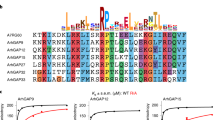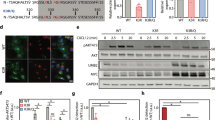Abstract
β-Arrestins are important in chemoattractant receptor-induced granule release, a process that may involve Ral-dependent regulation of the actin cytoskeleton. We have identified the Ral GDP dissociation stimulator (Ral-GDS) as a β-arrestin-binding protein by yeast two-hybrid screening and co-immunoprecipitation from human polymorphonuclear neutrophilic leukocytes (PMNs). Under basal conditions, Ral-GDS is localized to the cytosol and remains inactive in a complex formed with β-arrestins. In response to formyl-Met-Leu-Phe (fMLP) receptor stimulation, β-arrestin–Ral-GDS protein complexes dissociate and Ral-GDS translocates with β-arrestin from the cytosol to the plasma membrane, resulting in the Ras-independent activation of the Ral effector pathway required for cytoskeletal rearrangement. The subsequent re-association of β-arrestin–Ral-GDS complexes is associated with the inactivation of Ral signalling. Thus, β-arrestins regulate multiple steps in the Ral-dependent processes that result in chemoattractant-induced cytoskeletal reorganization.
This is a preview of subscription content, access via your institution
Access options
Subscribe to this journal
Receive 12 print issues and online access
$209.00 per year
only $17.42 per issue
Buy this article
- Purchase on Springer Link
- Instant access to full article PDF
Prices may be subject to local taxes which are calculated during checkout








Similar content being viewed by others
References
Lauffenburger, D. & Horwitz, A. Cell migration: a physically integrated molecular process. Cell 84, 359–369 (1996).
Sandborg, R. & Smolen, J. Early biochemical events in leukocyte activation. Lab. Invest. 59, 300–320 (1988).
Schiffmann, E. et al. The isolation and partial characterization of neutrophil chemotactic factors from E. coli. J. Immunol. 114, 1831–1837 (1975).
Witko-Sarsat, V., Rieu, P., Descamps-Latscha, B., Lesavre, P. & Halbwachs-Mecarelli, L. Neutrophils: molecules, functions, and pathophysiological aspects. Lab. Invest. 80, 617–653 (2000).
Weiner, O. D. et al. Spatial control of actin polymerization during neutrophil chemotaxis. Nature Cell Biol. 1, 75–81 (1999).
Barlic, J. et al. Regulation of tyrosine kinase activation and granule release through β-arrestin by CXCR1 Nature Immunol. 1, 227–233 (2000).
M'Rabet, L. et al. Differential fMet-Leu-Phe- and platelet-activating factor-induced signaling toward Ral activation in primary human neutrophils. J. Biol. Chem. 274, 21847–21852 (1999).
Takai, Y., Sasaki, T. & Matozaki, M. Small GTP-binding proteins. Physiol. Rev. 81, 153–208 (2001).
Brymora, A., Valova, V. A., Larsen, M. R., Roufogalis, B. D. & Robinson, P. J. The brain exocyst complex interacts with RalA in a GTP-dependent manner: identification of a novel mammalian Sec3 gene and a second Sec15 gene. J. Biol. Chem. 276, 29792–29797 (2001).
Volknandt, W., Pevsner, J., Elferink, L. A. & Scheller, R. H. Association of three small GTP-binding proteins with cholinergic synaptic vesicles. FEBS Lett. 317, 53–56 (1993).
Mark, B., Jilkina, O. & Bhullar, R. P. Association of Ral GTP-binding protein with human platelet dense granules. Biochem. Biophys. Res. Commun. 225, 40–46 (1996).
de Leeuw, H. P. et al. Small GTP-binding protein Ral modulates regulated exocytosis of von Willebrand factor by endothelial cells. Arterioscler. Throm. Vasc. Biol. 21, 899–904 (2001).
de Leeuw, H. P., Wijers-Koster, P. M., van Mourik, J. A. & Voorberg J. Small GTP-binding protein RalA associates with Weibel-Palade bodies in endothelial cells. Thromb. Haemost. 82, 1177–1181 (1999).
Nakashima, S. et al. Small G protein Ral and its downstream molecules regulate endocytosis of EGF and insulin receptors. EMBO J. 18, 3629–3642 (1999).
Sawamoto, K. et al. Ectopic expression of constitutively activated Ral GTPase inhibits cell shape changes during Drosophila eye development. Oncogene 18, 1967–1974 (1999).
Lee, T., Feig, L. & Montell, D. J. Two distinct roles for Ras in developmentally regulated cell migration. Development 122, 409–418 (1996).
Suzuki, J. et al. Involvement of Ras and Ral in chemotactic migration of skeletal myoblasts. Mol. Cell. Biol. 20, 4658–1665 (2000).
Goi, T. et al. An EGF receptor/Ral-GTPase signaling cascade regulates c-Src activity and substrate specificity. EMBO J. 19, 623–630 (2000).
Frankel, P. et al. Ral and Rho-dependent activation of phospholipase D in v-Raf transformed cells. Biochem. Biophys. Res. Commun. 255, 502–507 (1999).
Jiang, H. et al. Involvement of Ral GTPase in v-Src induced phospholipase D activation. Nature 378, 409–412 (1995).
Albright, C. F., Giddings, B. W., Liu, J., Vito, M. & Weinberg, R. A. Characterization of a guanine nucleotide dissociation stimulator for a Ras-related GTPase. EMBO J. 12, 339–337 (1993).
Wolthuis, R et al. Ras-dependent activation of the small GTPase Ral. Curr. Biol. 18, 471–474 (1998).
Hofer, F. et al. Ras-independent activation of Ral by a Ca2+-dependent pathway. Curr. Biol. 8, 839–842 (1998).
Santini, F., Penn, R. B., Gagnon, A. W., Benovic, J. L. & Keen, J. H. Selective recruitment of arrestin-3 to clathrin coated pits upon stimulation of G protein-coupled receptors. J. Cell Sci. 113, 2463–2470 (2000).
Ohta, Y., Suzuki, N., Nakamura, S., Hartwig, J. H. & Stossel, T. P. The small GTPase RalA targets filamin to induce filopodia. Proc. Natl Acad. Sci. USA 96, 2122–2128 (1999).
Glogauer, M., Hartwig, J. & Stossel, T. Two pathways through Cdc42 couple the N-formyl receptor to actin nucleation in permeabilized human neutrophils. J. Cell Biol. 150, 785–796 (2000).
Hartt, J. K., Barish, G., Murphy, P. M. & Gao, J. L. N-formylpeptides induce two distinct concentration optima for mouse neutrophil chemotaxis by differential interaction with two N-formylpeptide receptor (FPR) subtypes. Molecular characterization of FPR2, a second mouse neutrophil FPR. J. Exp. Med. 190, 741–747 (1999).
Su, S. et al. A seven-transmembrane, G protein-coupled receptor, FPRL1, mediates the chemotactic activity of serum amyloid A for human phagocytic cells. J. Exp. Med. 189, 395–402 (1999).
Ferguson, S. S. G. Evolving concepts in G protein-coupled receptor endocytosis: the role in receptor desensitization and signaling. Pharmacol. Rev. 53, 1–24 (2001).
Matsubara, K. et al. Plasma membrane recruitment of RalGDS is critical for Ras-independent Ral activation. Oncogene 18, 1303–1312 (1999).
Rosario, M., Paterson, H. F., & Marshall, C. J. Activation of the Ral and phosphatidylinositol 3′ kinase signaling pathways by the ras-related protein TC21. Mol. Cell. Biol. 21, 3750–3762 (2001).
Hirsch, J. A., Schubert, C., Gurevich, V. V. & Sigler, P. B. The 2.8 Å crystal structure of visual arrestin: a model for arrestin's regulation. Cell 97, 257–269 (1999).
Chung, C. Y., Lee, S., Briscoe, C., Ellsworth, C. & Firtel, R. A. Role of Rac in controlling the actin cytoskeleton and chemotaxis in motile cells. Proc. Natl Acad. Sci. USA 97, 5225–5230 (2000).
Quinn, M. T. Low-molecular-weight GTP-binding proteins and leukocyte signal transduction. Leukocyte Biol. 58, 263–276 (1995).
Fong, A. M. et al. Defective lymphocyte chemotaxis in β-arrestin2- and GRK6-deficient mice. Proc. Natl Acad. Sci. USA 99, 7478–7483 (2002).
Ferguson, S. S. G. et al. Role of β-arrestin in mediating agonist-promoted G protein-coupled receptor internalization. Science 271, 363–366 (1995).
Luttrell, L. et al. β-Arrestin-dependent formation of β2 adrenergic receptor–Src protein kinase complexes. Science 283, 655–661 (1999).
DeFea, K. A. et al. β-Arrestin-dependent endocytosis of proteinase-activated receptor 2 is required for intracellular targeting of activated ERK1/2. J. Cell. Biol. 148, 1267–1281 (2000).
Miller, W. E. et al. β-Arrestin1 interacts with the catalytic domain of the tyrosine kinase c-SRC. Role of β-arrestin1-dependent targeting of c-SRC in receptor endocytosis. J. Biol. Chem. 275, 11312–11319 (2000).
McDonald, P. H. et al. β-Arrestin 2: a receptor-regulated MAPK scaffold for the activation of JNK3. Science 290, 1574–1577 (2000).
Luttrell, L. M. et al. Activation and targeting of extracellular signal-regulated kinases by β-arrestin scaffolds. Proc. Natl Acad. Sci. USA 98, 2449–2454 (2001).
Claing, A. et al. β-Arrestin-mediated ADP-ribosylation factor 6 activation and β2-adrenergic receptor endocytosis. J. Biol. Chem. 276, 42509–42513 (2001).
Wenzel-Seifert, K., Lentzen, H., Aktories, K. & Seifert, R. Complex regulation of human neutrophil activation by actin filaments: dihydrocytochalasin B and botulinum C2 toxin uncover the existence of multiple cation entry pathways. J. Leukocyte Biol. 61, 703–711 (1997).
Rothwell, S. W., Nath, J. & Wright, D. G. Interactions of cytoplasmic granules with microtubules in human neutrophils. J. Cell Biol. 108, 2313–2326 (1989).
Bai, C. & Elledge, S. J. Gene identification using the yeast two-hybrid system. Methods Enzymol. 283, 141–156 (1997).
Liu, Q. et al. Effect of decaglycerol mono-oleate on chemiluminescence of human neutrophils. Luminescence 14, 327–330 (1999).
Seachrist, J. L. et al. Rab5 association with the angiotensin II Type 1A receptor promotes Rab5 GTP-binding and vesicular fusion. J. Biol. Chem. 277, 679–685 (2002).
Miki, H., Yamaguchi, H., Suetsugu, S. & Takenawa, T. IRSp53 is an essential intermediate between Rac and WAVE in the regulation of membrane ruffling. Nature 408, 732–735 (2000).
Acknowledgements
We thank C. Kubu, E. Li, C. Godin and A. Shin for technical assistance. We thank L. Limbird for helpful discussions. M.B. is the recipient of a Canadian Institutes of Health Research (CIHR) Fellowship, A.V.B. is the recipient of a Canadian Hypertension Society/CIHR Fellowship, J.M.V. is a CIHR Scholar, R.D.F. holds a Heart and Stroke Foundation of Ontario (HSFO) Career Scientist Award and S.S.G.F. is the recipient of Heart and Stroke Foundation of Canada MacDonald Scholarship, Premier's Research Excellence Award and Canada Research Chair in Molecular Neuroscience. This work was supported by HSFO grant T4987 and CIHR grant MA-15506 to S.S.G.F, CIHR MT-10864 to R.J.R. and CIHR grant 43959 to R.D.F.
Author information
Authors and Affiliations
Corresponding author
Ethics declarations
Competing interests
The authors declare no competing financial interests.
Supplementary information
Supplementary movie
Time-lapse recording of membrane ruffling in response to fMLP receptor activation. Shown are two HEK 293 cells, one cell expresses GFP-tagged fMLP receptor (green) alone and the other cell co-expresses Ds-Red1-tagged Ral-GDS clone 284 (red) with GFP-tagged fMLP receptor. The cells correspond to the micrograph presented in Fig. 2b. Membrane ruffling is initiated in the cell lacking Ds-Red1- tagged Ral-GDS clone 284 by the addition of 100 nM fMLP to the dish. The movie is comprised of a time series of 133 confocal images scanned at 15 s intervals. The footage is repeated twice and the presentation speed is accelerated 60 times normal (1s = 1min). (AVI 4483 kb)
Rights and permissions
About this article
Cite this article
Bhattacharya, M., Anborgh, P., Babwah, A. et al. β-Arrestins regulate a Ral-GDS–Ral effector pathway that mediates cytoskeletal reorganization. Nat Cell Biol 4, 547–555 (2002). https://doi.org/10.1038/ncb821
Received:
Revised:
Accepted:
Published:
Issue Date:
DOI: https://doi.org/10.1038/ncb821
This article is cited by
-
An integrated approach for identification of a panel of candidate genes arbitrated for invasion and metastasis in oral squamous cell carcinoma
Scientific Reports (2021)
-
Identification of oral cancer related candidate genes by integrating protein-protein interactions, gene ontology, pathway analysis and immunohistochemistry
Scientific Reports (2017)
-
Endothelin A receptor drives invadopodia function and cell motility through the β-arrestin/PDZ-RhoGEF pathway in ovarian carcinoma
Oncogene (2016)
-
RILP suppresses invasion of breast cancer cells by modulating the activity of RalA through interaction with RalGDS
Cell Death & Disease (2015)



